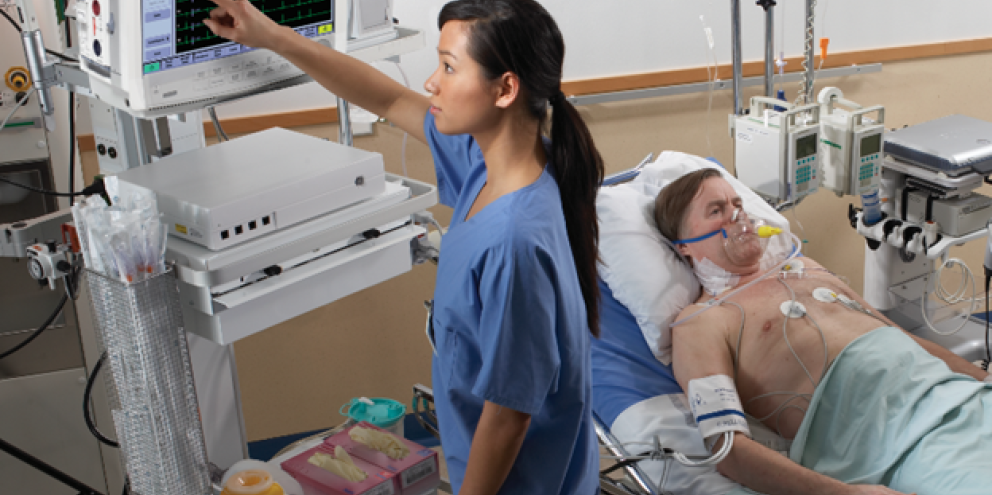
Does every patient in the ICU need ECG monitoring?
Yes, if they are in hemodynamic, respiratory, or neurologic distress then of course you need continuous cardiac monitoring. It must be included for every patient in order to have prompt monitoring to evaluate rapid deterioration.
Heart rate helps monitor deterioration and therapy response. A patient’s heart rate increases before their arterial pressure drops so heart rate is vital to monitor continuously.
What patient parameters are used to determine if a patient needs ECG monitoring outside of the ICU?
Let’s say the ICU is full and there are no beds available. Or the patient is not critical enough to require ICU admission. Here are the patients that should be on continuous cardiac monitoring:
- Heart rate <40 or >150 (>120 bpm if a cardiac disease is known)
- Suspected myocardial ischemia
- QT correct greater 500 millisecond (or rapid increase in qTC >60 msec from baseline)
- Patients in respiratory distress, acute desaturation less than 92%
- AMS with cerebral ischemia
- Severe electrolyte abnormality
- Ventricular arrhythmia
- Sustained supraventricular arrhythmia
Do you prefer intermittent or continuous ECG monitoring?
In the ICU you need continuous monitoring. Intermittent monitoring is for patients who are stable and will not deteriorate quickly.
Additionally, if someone is mobile, this would make continuous monitoring difficult to achieve if telemetry is not available, making intermittent ECG monitoring ideal.
In the event that a hospital isn’t equipped for continuous monitoring or there is a lack of continuous monitors available for all patients – there are parameters to qualify a patient priority for continuous ECG monitoring.
Heart rate and other vital signs (arterial pressure, body temperature, oxygen saturation, respiratory rate) are vital parameters, and they need to be monitored continuously. If patients are stable for 24-48 hours, you can use intermittent ECG monitoring. For example, to evaluate the ECG evolution of a recent myocardial infarction or the behavior of QT interval.
Using the information from the intermittent ECG, will guide how frequently you need to monitor ECG, either on an intermittent basis or increased to continuous monitoring.
Can ECG monitoring be used as a predictive tool i.e., to predict potential deterioration in a patient?
Definitely. When I’m on shift the first thing I look at is the heart rate and discuss with the nurse the patient’s trends. This is important because heart rate is compensatory.
If the heart rate is lower, there is something wrong with impulse generation or impulse conduction. If it’s higher this means something is bothering the patient. For example, cardiac issues (heart failure, myocardial ischemia) or non-cardiac issues (fever, sepsis, bleeding).
Heart rate is the first parameter that modifies before a deleterious cascade starts. Heart rate is critical in two ways - predicting deterioration and looking at the response of therapy. This can be quickly monitored by looking at the heart rate trends.
Clinicians tend to look at blood pressure which is a measure of cardiac output. But blood pressure is a late parameter, and it is often too late when it changes.
Do you think ECG monitoring in the ICU can help clinicians with clinician decision-making and improve patient outcomes?
Yes. Take, for example, gastrointestinal bleeding. In order to know if the patient needs to be transferred immediately for endoscopy, you look at vital parameters as well as arterial blood gases.
Heart rate tells you if the patient is getting worse, if you need to do any diagnostic testing, and drives therapy decision-making.
Three ways ECG monitoring helps clinicians with clinical decision making: Anticipating deterioration, evaluating if the therapy is working, and driving any diagnostic tools.
Do COVID-19 infections impact the cardiovascular system and are there hallmark ECG changes associated with COVID infections?
Yes, there are two ways COVID-19 infections impact the cardiovascular system – in direct and indirect ways.
Direct ways include myocarditis (inflammation) and acute thrombosis (leading to myocardial infarction and pulmonary embolism). Indirect ways include decreased oxygen saturation due to pneumonia, decreased arterial pressure, electrolyte abnormalities, anemia, and cytokine storm. All these indirect ways increase the risk of ischemia and arrhythmias.
As far as hallmark ECG changes, for example, the Osborn wave that you see with hypothermia, there is not a specific sign or wave in ECG indicative of COVID infection.
Even though there is no consistent or hallmark ECG change seen, ECG readings can be altered in many ways due to the direct and indirect consequences of COVID-19 infections.
Certain changes include ischemia, arrhythmia, QTc alterations, de novo intraventricular conduction delay. And all of them correlate with COVID-19 severity and with prognosis.
Is frequent ECG monitoring helpful for clinicians when managing COVID-19 patients?
Yes, definitely but not all COVID-19 patients need frequent or continuous ECG monitoring.
With continuous monitoring, you can monitor for deterioration more closely in patients who have COVID-19 infections. When we had many COVID-19 patients in 2020, we saw many times oxygen saturation quickly decreasing and heart rate increasing. This often meant the patient had a pulmonary embolism, worsening pneumonia or worsening pleural effusion, or atelectasis due to mucus plugs blocking the respiratory tree. So any time the heart rate went up, we always looked for a specific cause. Heart rate changes in COVID-19 patients prompted us to perform diagnostic and/or laboratory tests
Moreover, once we saw their heart rate going up, we performed an ECG to look for cardiac ischemia. Those findings would determine if the patient needed to be watched closely with continuous ECG monitoring.
Do you think ECG monitoring in COVID-19 patients is essential?
If the patient is in the ICU, then of course, they need continuous ECG monitoring. If the patient is not in the ICU, there are parameters we use to determine if continuous ECG monitoring is essential. If oxygen saturation is less than 92% or if the patient is on noninvasive mechanical ventilation, then they would need continuous monitoring.
Lab values can also determine if it is needed, for example, if the patient has very high C-reactive protein, interleukin-6, or d-Dimer levels then they should be on continuous ECG monitoring.
Lastly, if CT scan shows more than 20-30% lung involvement in a patient with COVID-19 – this patient should be on continuous monitoring.
COVID-19 patients should be monitored like other patients in the ICU, especially since we now know how to manage and treat the disease and have various therapies available.
How often should patients with COVID-19 have ECGs or be connected to continuous ECG monitoring (only during active treatment or for a period of time post-recovery)?
Baseline and intermittent ECG monitoring (every 3 days) is usually appropriate at hospital discharge.
ECG at 2, 4, and 24 hours post antibiotic or antiviral initiation is the protocol I follow.
QTc changes also dictate ECG intervals in patients with COVID-19.
After the patient is discharged, they would have an ECG with transthoracic echo one month post-discharge. This is to look for pericardial involvement including pericarditis.
If they don’t need cardiology rehabilitation, then monitoring at home is not necessary.
Closing Thoughts from Dr. Cosentino
Heart rate is a vital parameter and should be stable. If it becomes unstable – then something is wrong. Look at why the heart rate has changed, look at the patient, and look for arrhythmias, and act before arterial hypotension ensues or peripheral hypoperfusion develops.
Looking at heart rate trends rather than absolute value is key.
In addition to heart rate, the ECG rhythm provides information about how the patient is doing and helps assess patient stability. Things like ST depression or elevation, QTc interval, and single or repetitive ectopic beats, are important to monitor along with heart rate in ECG.
When in doubt, put a patient on continuous monitoring until you are convinced the patient is stable. By monitoring closely, you can monitor for deterioration, and you will not miss life-threatening arrhythmias.

Dr. Nicola Cosentino
Dr. Nicola Cosentino, a member of the AHA/ASA and of the Royal Society of Medicine, is a practicing clinician at the Monzino Cardiology Center in Milan, Italy, who specializes in the treatment of patients with acute cardiovascular diseases.
Dr. Cosentino is a member of the PhD program in Translational Medicine at the University of Milan, Italy and has been the receiver of several grants since 2014. He is a member of the editorial board of the Journal of Clinical Medicine, Frontiers of Cardiovascular Medicine, and has reviewed several scientific journals. In addition to his clinical practice,
Dr. Cosentino teaches Cardiology in the University of Medicine; as well as, the Cardiology Medical School of Milan, Italy. Dr. Cosentino is the author of over one hundred scientific publications and has written several medical book chapters.








